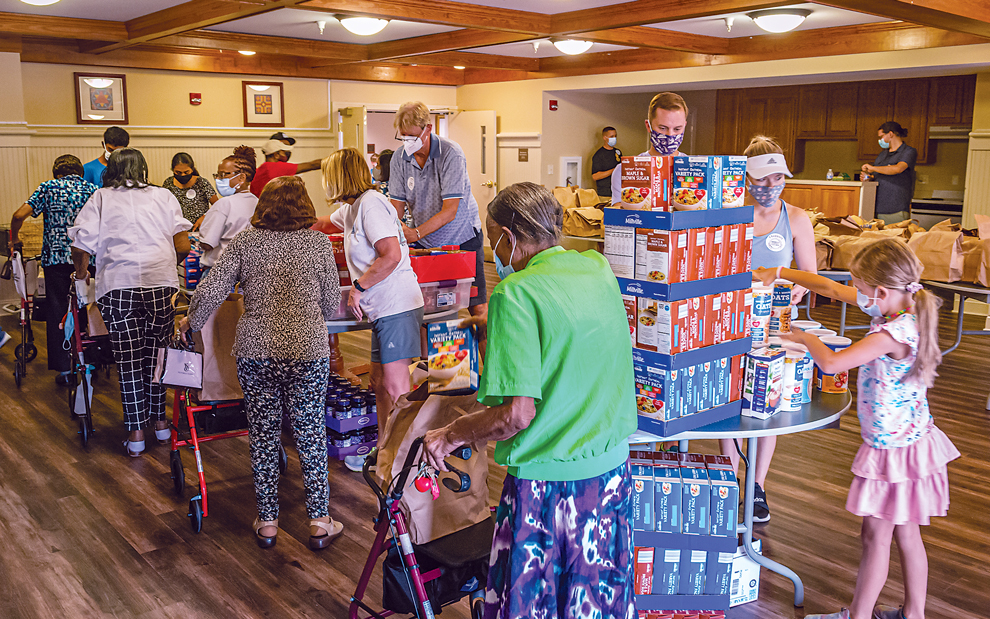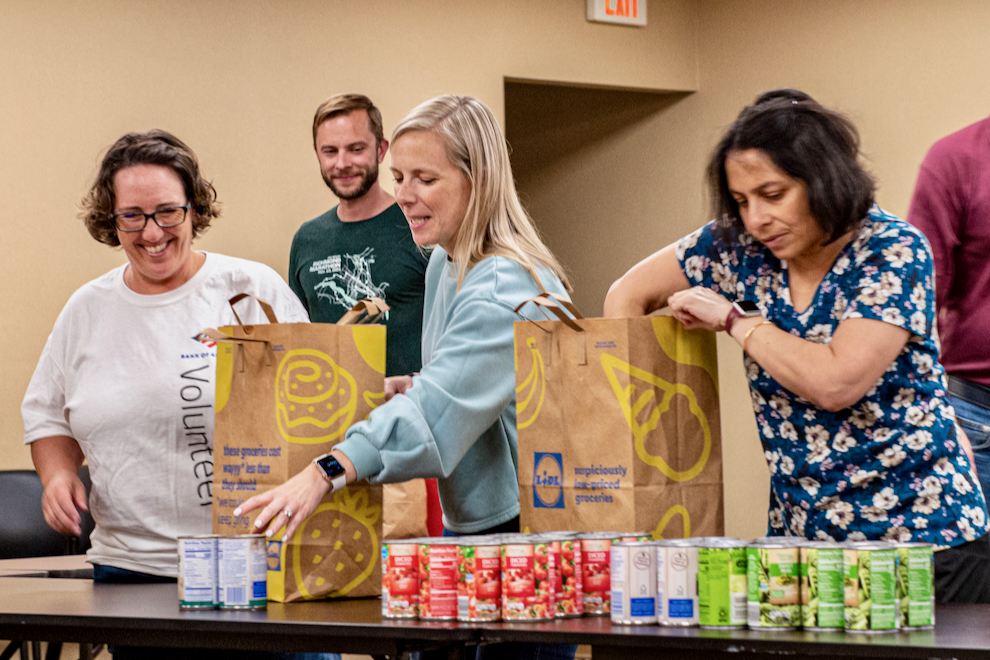Millions of families struggle every day with putting food on their tables. While the number of people living with hunger has hovered at 10 percent of the U.S. population for decades, the past three years have brought a roller coaster of challenges.
“We’ve had back-to-back situations that have caused a huge amount of stress on households,” says Kim Hill, executive director of the Chesterfield Food Bank Outreach Center. “First, the pandemic, then inflation, then the ending of emergency SNAP allotments. It’s just one hit after another.”
History of Hunger
The first federal food stamp program was initiated in 1939 as part of President Franklin D. Roosevelt’s New Deal. While that system ended in 1943, the federal government reinstated food stamps in 1961 under President John F. Kennedy and strengthened the initiative in 1964 with the Food Stamp Act, part of President Lyndon B. Johnson’s Great Society, a series of policy initiatives.
Now known as the Supplemental Nutrition Assistance Program, or SNAP, the aid is designed to support nutrition for low-income working families, low-income adults sixty and older, people with disabilities who have fixed incomes, and anyone else who meets income requirements. More than 41 million Americans receive SNAP benefits.
When the pandemic began in March 2020, Congress created emergency SNAP allotments, raising the existing monthly benefit amounts to the maximum allowable based on household size rather than income limits. But those emergency allotments (EAs) have now ended, with Congress passing a law in December 2022 to stop the additional funding by the end of February of this year.
“What that is doing is sending millions of Americans off the hunger cliff,” says Shannon Maynard, executive director of the Congressional Hunger Center, a Washington, D.C.-based nonprofit whose goal is to end hunger worldwide by educating and training leaders to work in the field. “We’re now seeing rising food costs at a time when the emergency allotments really helped people who were already hurting before the pandemic. [The EAs] lessened the impact for those who were pushed into food insecurity as a result of the pandemic. Those benefits are expiring at a time when food inflation and rent inflation are really challenging families.”
According to U.S. Department of Agriculture research, 10.2 percent (or 13.5 million) of U.S. households were food insecure through 2021. That’s not a significant difference from the 2020 figure of 10.5 percent, which matched 2019’s figures. However, 2019 marked the first year that food insecurity was statistically significantly lower than the 11.1 percent of food insecurity in pre-recession 2007. In 2008, the food insecurity rate increased to nearly 15 percent.
“The reality is, we have a chronic, stubborn problem with hunger,” Maynard says. “It sits around 10 percent. It seems we are comfortable with one in 10 of us [in this country] not knowing where our next meal is coming from.”
The Local State of Hunger
In Central Virginia, Feed More is the organization where neighborhood and community pantries, both large and small, obtain food they can then pass to people in need. In 2022, Feed More distributed close to 40 million pounds of food; nearly 11 million pounds were fresh produce. The organization currently operates out of a 92,000-square-foot campus in the city of Richmond; a new Henrico County location is planned for 2024.
“During the last few months, we’ve seen a steady increase in calls to our Hunger Hotline from folks in need of emergency food assistance,” says Doug Pick, Feed More’s president and CEO. “While it’s too early to tell the impact of the SNAP benefits returning to pre-pandemic status, we anticipate an outsized impact on our elderly neighbors and those with chronic conditions and living on fixed incomes.”
The Chesterfield Food Bank Outreach Center is Feed More’s largest partner agency, serving people in a variety of ways, including seven weekly distribution locations, a summer distribution program at schools, a community kitchen where other organizations can prepare meals for delivery, and an emergency program for people with sudden need.
“When COVID hit in 2020, we grew 400 percent in our services, and we saw a two-mile backup on Route 10,” says Hill, the executive director. “We were able to turn on a dime and start serving people immediately to keep everybody healthy.”
While the number of people they serve dipped slightly in 2022, the organization is still serving more people than before the pandemic. “This is the new normal,” Hill says. “We have a liberal registration process, so we reach not only the most impoverished families but also those who are working and are trying to make it, and they just can’t put food on the table as they did before.”
Nearly 90 percent of those who receive support from the Chesterfield Food Bank are county residents, but Hill notes that some ZIP codes are shared among Chesterfield and the cities of Richmond, Petersburg, and Hopewell. “We don’t ask what side of the street you live on,” she says. “Every person who has an emergency food situation will be served the first time. If [people requesting food] live outside our service area, we give them the information they need to check with pantries in their area.”

Stocking Food Banks to Serve Others
In addition to serving more people in need, organizations are facing increased challenges in sourcing and paying for the food they can provide. Local organizations can purchase food from Feed More for cents on the dollar, but the need is such that Hill says she has had to look for other food sources, including out-of-state manufacturers. “Maybe they have a nonprofit program, so they’re willing to sell at a reduced rate,” Hill says.
Donations of food and money to pantries have dropped in recent months, says Kristin Cummings, director of St. Thomas’ Food Pantry in Ginter Park. “They’ve passed the urgency phase,” she says. “In the pandemic, people wanted to do something, so they sent money and donations, and we have wonderful donors. But donations overall are down. People are experiencing higher costs of everyday living, which has led to smaller cash donations.”
Yet the need remains high, Cummings notes. Before the pandemic began, St. Thomas’ Food Pantry was providing food for seventy-five to one hundred families a week. The pantry is now serving 250 to 350 families a week. St. Thomas’ pantry is open on Thursday afternoons, fifty-one weeks a year – taking a break only for Thanksgiving. In all of 2022, the pantry served 31,481 individuals and 17,388 households.
Cummings has a budget of $300 per week to feed all who come. She purchases food from Feed More and the USDA and partners with local businesses who may sell at a reduced price or let food bank volunteers collect unsold leftovers.
Pre-pandemic, the pantry used a choice model, where clients were able to walk through a church hall – filled with tables and shelves loaded with goods – and select what they wanted and needed. With the advent of the pandemic, the pantry began offering a drive-through service. Now, a walk-up option is also available.
“It’s our goal to return to the choice model,” Cummings says, noting that they’ve had to hire police to manage traffic around the church, which sits in a residential neighborhood. “The drive-through line wraps around the building.”
In addition to food, walk-up visitors can have their blood pressure checked at a wellness table or meet with a volunteer social worker who may be able to assist with other needs, like how to obtain a government ID, pay a bill, launch a job search, or secure government benefits. A coffee station is also routinely offered.
“We believe in hospitality,” Cummings says, “Dignity is at the forefront of everything. We tell our volunteers to think of the person they are helping as their most beloved family member and treat them as such. We are aware we have a lot of privilege and that it could be us on the other side.”
Cummings says the food pantry team is always brainstorming ways they can serve those who come for assistance. Thanks to a grant from the American Heart Association, the pantry is offering a chef-led, four-week heart-healthy cooking course. When the pantry received an abundance of split peas and lentils, a volunteer researched recipes and printed sheets to include in food bags. The pantry has also instituted a suggested monthly donation, to help round out the offerings or provide something that might not always be available. April’s item was toilet paper; May’s is canned fruit. “One ask was tuna and mayonnaise,” Cummings says, adding that jelly, packaged in plastic jars, is always welcome. “We rarely get jelly – it’s so expensive.”
Fighting Hunger Where Families Live
A significant challenge of food distribution is getting the food to the people who need it most. “Most of us take it for granted that we have a car, we have gas in the car, and we can pop in and go about our business whenever we want,” says Sudeshna Das-Menezes, founder of the Henrico Community Food Bank. “That’s not the case [for many people]. They have no car or one car, and everything revolves around when that car is available.”
Das-Menezes worked at Feed More for nearly seventeen years in a variety of roles. She left the organization in February 2021, thinking about what she should do next. And she noticed how many people were coming to her, asking about where they could find food in Henrico County, where she lives. “The food landscape had changed,” she says.
With her husband, Das-Menezes crafted a case study about food insecurity in Henrico and presented it to the deputy county manager for community affairs, Monica Smith-Callahan. “She said our case study reflected what the county was seeing on the ground,” Das-Menezes says. “[Smith-Callahan] said, ‘We’ve known this for a while and want to do something.’ From that point on, it’s been nonstop.”
The original vision for a new Henrico-based food pantry was to reach into all five magisterial districts with distribution events. Noting that there wasn’t an “angel donor” to fund a brick-and-mortar site, Das-Menezes instead partnered with other community organizations, as well as Henrico County, to establish distribution sites. Still, she heard from many people that getting to and from those sites is hard.
That’s when she began delivering to people’s homes. “We completely changed our model to be mobile,” she says. “In Henrico, we have more than nine percent of people living in poverty – that’s 30,000 people. I never thought poverty and hunger could exist throughout the five magisterial districts, but having made deliveries myself, I’ve seen poverty in every ZIP code. We cannot say, ‘It’s not in my jurisdiction.’ It’s in every jurisdiction.”
People can request a food delivery once a month to their door. The bag, weighing at least thirty pounds, often contains cereal or oatmeal, pasta and sauce, canned vegetables, boxed macaroni and cheese, beans, and bags of rice or lentils. Food drives supply snack items like applesauce or granola bars. “We can’t provide [all a family’s needed] groceries for a week,” Das-Menezes says. “But we hope to save families $75 a week that can go toward clothing, a book, or a birthday cake for a child. Life is about living. It’s so easy to forget the little things that bring us joy.”
In February 2023, Henrico County offered the community food bank space in a former county school on Hartman Street. “Having that space is a total game-changer for us,” Das-Menezes says. “Donors can come with donations, and volunteers can come to help. It allows people to see something tangible. With a mobile operation, you don’t always see [the impact]. Henrico County has been watching us grow, and I am so grateful they took a leap of faith [with us]. They gave us our first seed funding and are our biggest champion.”
While the Henrico Community Food Bank does have a registration process, it’s not income-based. “We know that situations can change at the drop of a hat,” Das-Menezes says. “Every time I do a client intake, I take on a piece of someone’s life. Picking up the phone and asking for something as basic as food is huge. Why do we want to make that harder?”
Food Justice for Families
Maynard of the Congressional Hunger Center remembers the first time she saw hunger up close. She volunteered with an after-school program for low-income K-12 students while she was an undergraduate at the University of Richmond.
“The kids would spit on their snacks so no one else would take their food,” she says. “Prior to seeing those kids, I equated hunger with homelessness. We have these myths [as a society] about who is food insecure and why they are. Do we expect that some people should not be able to feed their families even though they’re working forty hours a week? Let’s bring back dignity to work. People don’t need these programs because of their own bad choices.”
As summer break nears and families grapple with providing the meals their kids might have received in the school setting, the Summer Food Service Program, administered by the Virginia Department of Education, will again offer food to Virginia families. To find information on local food distribution sites for summer 2023, text FOOD or COMIDA to 304-304. For the latest research on hunger in communities, workable solutions, and ideas to help end hunger, visit zerohungeracademy.org. For food needs today or in the near future, visit feedmore.org.





